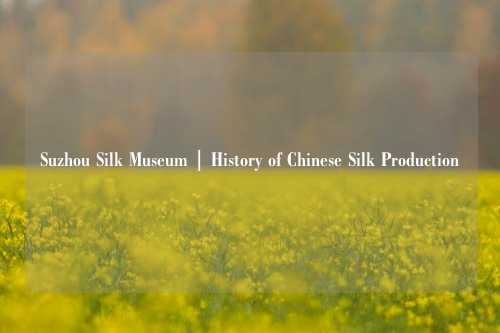Suzhou Silk Museum | History of Chinese Silk Production
Discover the history of Chinese silk production through the lens of the Suzhou Silk Museum. This article takes you on a journey through time, exploring the origins, evolution, and significance of silk in Chinese culture and the role Suzhou played in this tradition.
The Timeless Allure of Chinese Silk

The history of Chinese silk production is a tale as old as time, steeped in luxury, artistry, and significance. For thousands of years, silk has been a symbol of prosperity, refinement, and the pinnacle of craftsmanship in China. From the legendary tale of the silkworm's origins to the methods of reel production, silk has woven its way into the very fabric of Chinese civilization.
At the heart of this legacy lies the city of Suzhou, a place where history and tradition converge to create a tapestry of silk culture. Known as the "Venice of China" for its picturesque waterways and architectural marvels, Suzhou is also celebrated as a cradle of silk production. The Suzhou Silk Museum stands as a testament to this enduring tradition, offering visitors a window into the past, present, and future of one of humanity's most cherished fabrics.
The museum's exhibits trace the history of silk back to its earliest beginnings. According to legend, the Chinese goddess嫘祖 (Léi Zǔ) is credited with discovering the secrets of sericulture—the cultivation of silkworms and the production of silk. This legendary invention marked the birth of an industry that would shape the economic, , and even political landscapes of ancient China. Silk became a prized commodity, not only for its beauty and softness but also for its status as a symbol of wealth and power.
As you explore the museum, you'll encounter displays that showcase the tools, techniques, and traditions of silk production through the ages. From the hand-spun reels of early silkworm farmers to the mechanized looms of the Ming and Qing dynasties, the museum provides a overview of how silk evolved from a simple thread into a sophisticated industry.
One of the most aspects of the museum is its focus on the significance of silk. In ancient China, silk was not only a fabric but also a medium for art and storytelling. Elaborate patterns, embroidery, and delicate textiles were used to create everything from royal garments to religious art. The museum's collection includes stunning examples of these works, each telling a story of China's rich heritage.
Suzhou: The Heart of Silk Production
Suzhou's role in the history of Chinese silk production cannot be overstated. For centuries, the city has been a hub of silkworm farming and silk weaving, leveraging its fertile land, favorable climate, and skilled artisans to produce some of the most beautiful and sought-after textiles in the world.
The museum highlights Suzhou's contribution to the silk industry, showcasing how the region's dedication to quality and innovation set it apart. During the Ming and Qing dynasties, Suzhou became synonymous with luxury silk, with its patterns and sophisticated techniques captivating both domestic and international audiences.
One of the museum's most impressive exhibits is its collection of silk-weaving machinery. Visitors can see firsthand how silkworms are raised, how their cocoons are processed, and how the delicate threads are transformed into the shimmering fabric we know as silk. These displays are complemented by informative descriptions, offering insights into the skill and dedication required to produce even a single piece of silk.
In addition to its historical exhibits, the Suzhou Silk Museum also emphasizes the modern relevance of silk. While methods are still preserved and practiced, the museum highlights how contemporary technologies and techniques are being integrated into the industry to ensure its continued relevance in the modern world.
For travelers interested in Chinese culture, the Suzhou Silk Museum is a must-visit destination. Its rich history, coupled with its stunning displays, provides a opportunity to delve into the heart of China's silk legacy. Whether you're a history enthusiast, a textile aficionado, or simply curious about the origins of one of the world's most beautiful fabrics, the museum offers a journey through time that is as informative as it is inspiring.
, the Suzhou Silk Museum is more than just a repository of historical artifacts—it is a celebration of the ingenuity, artistry, and heritage that define Chinese silk production. As you walk through its halls, you'll gain a deeper appreciation for the skill, creativity, and passion that went into every thread, every pattern, and every piece of fabric on display.
















